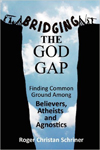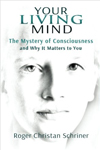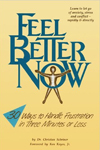Your Living Mind was published in late 2014. It was the biggest book project I have ever undertaken, requiring three years, and giving expression to 20 years of reflection about the mystery of consciousness. Here is basic information about this book, plus most of the Introduction:
Being conscious creatures makes us radically different from teacups, snowflakes, or single cells of our own bodies, but we struggle to say just what it is that makes consciousness special. Today there is good news and bad news about this seemingly impenetrable mystery.
First the good news – philosophers and cognitive scientists have managed to articulate some of the key features that make consciousness extraordinary. The bad news is that these clever conceptual breakthroughs have led us into further conundrums. It has been maddeningly difficult to reconcile some recent theories of consciousness with the way science thinks about the physical universe, and this has stirred up the old mind-body dispute. How could consciousness occur within the brain, or relate to the brain at all? And what’s really appalling is that it’s hard to make sense of consciousness in any terms whatsoever – physical or spiritual, religious or secular.
Your Living Mind explains issues being hotly debated by experts who have studied consciousness in depth. If you liked Consciousness Explained by Daniel Dennett or Soul Dust by Nicholas Humphrey, or you have enjoyed readable books and articles about neuroscience, I think you’ll enjoy Your Living Mind. It’s a multifaceted meditation on being a “minded brain” – an invigorating workout for both your intellect and your imagination.
Your Living Mind is partially intended for scholars, such as philosophers and cognitive scientists, but it was also written for a broad range of readers outside of academic circles. In addressing these two audiences, some compromises have been necessary. I need to provide scholars with solid documentation and technical detail, but I do not want to burden others with wearisome complexity. Therefore a great deal of scholarly material has been placed in the footnotes. I have also marked some difficult sections as optional, as I explain in the Introduction.
Although it is difficult to write for two readerships, this unusual approach has unusual benefits. Lay readers can choose when to dive more deeply into topics that especially interest them, perusing footnotes and technical sections and reflecting on esoteric “thought experiments.” Professionals may find that discussing consciousness in everyday language sheds light on longstanding controversies. Sometimes academic jargon obscures rather than clarifies.
Your Living Mind is available from Amazon.com, or purchase a signed copy directly from me. For ordering information, email rcschriner@aol.com. Amazon:
Here are excerpts from the Introduction of Your Living Mind. Passages that are not included below are marked with ellipses: … I have also omitted some footnotes.
INTRODUCTION
Sprinting Through a Mental Hall of Mirrors
The most beautiful thing we can experience is the mysterious.
It is the source of all true art and all science. – Albert Einstein
Even in the hurried pace of everyday life we sometimes find ourselves stunned by fundamental mysteries, and three of these enigmas are especially arresting. The first mind-boggler is that anything exists at all. The second wonder is the appearance of living creatures. And the third jaw-dropper is that some living creatures have conscious experiences.
The second mystery, of course, is closely related to the third. When people speak of the wonder of life, what they often mean is the wonder of being conscious. Daisies and dandelions are amazing even if they lack a single shred of sentience, but adding consciousness to living matter is the slickest trick of all.
Consciousness is such a familiar miracle that we usually ignore it, but this remarkable phenomenon is at the core of our sense of self. We are intimately entangled with the flow of our own experiences, in every waking moment and even in our dreams. …
Consciousness is also at the heart of our sense of value. We value sentient beings in a way that is radically different from the way we value anything else. Many of us would agree that it is wrong to casually destroy a conscious creature. By contrast, when I drink a glass of water I assume that nothing tragic occurs when it plunges into an acid bath in my stomach. I do not imagine the water silently screaming, “Ohhh nooooo!” – SPLASH! The difference in value between me and a tumbler of H2O involves the fact that I am conscious and it is not.
The mind-brain problem
Your Living Mind is especially concerned with vivid and sensuous experiences – pleasures, pains, tickles, tingles, the crack! of thunder, the luscious allure of chocolate mousse, and the hallucination of seeing two bright green gorillas grilling hot dogs in your kitchen. (Did you have a faint mental image of greenish apes just then?) We would not enjoy these perceptions if we were rocks, frisbees, or Deep Blue, the chess-playing computer. In this book we will consider a question that curious minds of all ages have contemplated. “What is this strange stuff inside of my mind?” (And some theorists reject the idea that conscious experiences are entities of any kind, or deny that “this stuff” is inside of us.)
Theologians have typically situated consciousness within the soul, but many scientists and philosophers believe it is somehow contained within the brain. When people report certain thoughts, emotions, impulses, and perceptions, brain scanners show characteristic kinds of neural activity. For better or for worse, we are learning to look into people’s heads and know at least some things about what they are thinking and feeling.
The close connections between the brain and conscious experiences are especially obvious when illness, aging, or trauma damages nerve tissue. Dementia can make an old grump become docile or a pacifist turn homicidal. Any major brain malfunction alters the way we think, feel, plan, and/or behave. Clearly brain and mind are tightly intertwined.
Of course, recognizing that the brain is intimately involved with human experience does not prove that experiences are nothing but brain activity. The brain may be an instrument of the mind, a tool that the mind (or soul) uses to express itself. But even if that’s true, it is important to discover whether certain key aspects of conscious awareness could literally be brain processes.
When I was young, I thought of consciousness as a sort of magical substance or energy that somehow appeared during the course of evolution. As animals developed from one-celled creatures into more complex organisms, at some point a miraculous light dawned in the darkness. But now I see that rather than being a ghostlike energy connected to the body, this light of awareness may be a new combination of the very same atoms that make up stones and water and stars.
As we will see, there are deep and disturbing questions about whether this could be so. How could a sensuous experience – the tingle of a caress, the scent of lilacs, the sight of day-glo orange – occur within a brain? Some contend that we can never answer this question satisfactorily. … They are not just worrying that consciousness is too complicated for us to grasp at this time. They believe that understanding how experiences occur within the brain is virtually impossible in principle, either because experiences do not occur within the brain or because we can never understand how this is so.
This book will wrestle with the remarkable issues associated with this conundrum, trying to show that human conscious experiences could be states of the brain.
Let me emphasize, we cannot yet prove that human consciousness is a brain state, but we are trying to discover whether this is possible in principle. And if you are already convinced that the mind is wedged between our ears, don’t be too sure that this is obvious. The puzzles involved are far more profound than I realized when I first immersed myself in this topic in the early 1990s. I feel as if I’ve been wrestling with a zen koan for two decades, and I have become excruciatingly aware of how hard it is to understand our own minds by looking within. It’s like trying to sprint lickety-split through an enormous hall of mirrors. Helmets and shin guards are strongly advised.
I realize that after reading Your Living Mind you may end up deciding that the mind can’t be in the brain after all. Regardless of your conclusions, I hope this book will remind you to appreciate the ongoing carnival of sensuous phenomena. Right now, as I see these words on my computer screen, the crisp black letters seem present in a remarkable way, vivid and obvious. I glance outside and a colorful panorama of luxuriant foliage seems spread out before me, manifest and undeniable. We owe it to ourselves to savor this astonishing gift, the living human mind.
One more point: Sometimes in exploring consciousness it seems as if a window has opened up unexpectedly and I have understood myself in a new way. I hope in reading Your Living Mind, new windows will open for you.
My personal fascination with the mind-body problem
I have always been interested in the big questions of life (philosophy, theology, ethics), and in why people think, feel, and act as they do (psychology, sociology, political science). Not surprisingly, introspection has been a hobby of mine. One of my favorite T-shirts shows a meditating Buddha above the caption, “Inquire Within.” At age 20 I was wondering whether to take up a musical instrument. I decided instead to focus my energies on a project in which I could be at the “keyboard” all day long, the project of noticing my thoughts, feelings, beliefs, desires, memories, daydreams, and anticipations. Whenever we’re awake, our own conscious experiences are always close at hand.
In college I majored in religion, philosophy, and psychology, and then earned a doctorate in religion and an M.S. in family therapy. I had planned to enter the ministry, but found myself drifting away from traditional religion. I became a Unitarian Universalist minister after learning that Unitarian Universalism welcomes people of all positive faiths and philosophies. I served congregations in Costa Mesa, Laguna Beach, and Fremont, California, and my speculations about mind and brain found their way into sermons and classes in these settings.
Many Unitarian Universalists are interested in science, and no one has seemed shocked when I say that the mind might be part of the brain. In fact quite a few UUs are secular humanists (atheists or agnostics) who assume that all reality is physical. Others accept traditional theologies, and they have critiqued my ideas in helpful ways.
Although I have not been an academic philosopher, in my ministry I have been a hands-on consultant about real-life philosophical dilemmas, crises, and confusions. Since I am a “practicing philosopher” rather than a philosophy teacher, I have both an unusual vantage point and significant limitations. I know a lot about philosophy of mind, but less about philosophy of language, theory of knowledge, ontology, and so on. Even so, an outsider can sometimes bring fresh perspectives to issues that have been discussed half to death.
In addition to ministry, I practiced psychotherapy for 25 years, and in the 1980s I wrote some books about psychological issues. I like to study complicated and confusing topics, looking for ways to discuss them in clear and practical terms. But I shifted toward philosophy in 1992 after reading Consciousness Explained by Daniel Dennett. Dennett is an insightful thinker and a fine writer, but I found his book shocking. Like many others, I felt it should have been called Consciousness Explained Away. I immediately presented two lectures critiquing his theory. I was particularly irked that he devalued introspection. Ever since I attended Gestalt Therapy groups in the 1970s, I have felt that focusing on exactly what I am experiencing at this moment, including my thoughts, emotions, and bodily sensations, is a gateway to self-understanding.
In grappling with Consciousness Explained, I started seeing ways to solve the problems Dennett discussed. I followed through by joining the American Philosophical Association and immersing myself in philosophy of mind. I subscribed to journals, read many articles and books, and regularly attended conferences and colloquia. Over time more and more puzzle pieces fit into place. I also gained confidence in my work as an independent scholar, partly because my criticisms of Dennett have been similar to those of many academicians. Even so, I must sheepishly admit that some of Dennett’s ideas now seem much more plausible than they did initially.
At this point I think I understand how, in principle, sensory experiences could occur within a brain, but powerful intellects have wrestled with this conundrum for centuries. If someone pokes gaping holes in my theory I will be disappointed but far from astonished. And if I actually have made progress toward solving this riddle, I will have done so only by learning from those who have gone before me, including Daniel Dennett.
An outsider’s view of academic philosophy
No doubt there are still cocktail-party conversations about Descartes, Nietzsche, and Sartre, but I wonder how many Bordeaux-sipping intellectuals discuss Dretske, Nagel, and Kripke. The relationship between academic philosophy and the general public is nearly non-existent. Professors mostly speak to each other, in a technical language full of confusing terms with multiple definitions – “qualia,” “intentionality,” “representationalism,” “epiphenomenalism,” and so on. A few, such as Dennett, have written for a wider audience, but most of them remain within their own ivory towers. I have spent years as the proverbial fly on the wall, listening to professorial interchanges within these lofty retreats. Your Living Mind opens a window into the intriguing story of this hidden conversation.
I am more and more impressed with the need for philosophical analysis. Philosophy is extremely difficult and extremely important, because it deals with issues that the human mind is ill-equipped to address. Humans are easily befuddled by words that have multiple meanings and by concepts that are hard to articulate. We struggle to understand arguments that involve more than three or four steps. We often let our emotions think for us, while logic lags behind as a rationalizing afterthought. And we like to imagine that our personal intuitions about the Big Questions are correct, assuming that those who disagree with us are either malicious or confused.
Philosophers are trained to surmount these limitations. They’re especially good at analyzing murky topics that are hard to even formulate coherently. At a recent philosophy colloquium someone mentioned the need for dealing with problems about which there is little hard data, but a whole lot of speculation based on what little data there is. “That’s us!” exclaimed the department chair, and hearty laughter ensued.
But there are problems with this profession, as many have observed. Freeman Dyson contends that compared to “the giants of the past, they are a sorry bunch of dwarfs. They are thinking deep thoughts and giving scholarly lectures to academic audiences, but hardly anybody in the world outside is listening. They are historically insignificant” (Dyson, “What Can You Really Know?” New York Review of Books, November 8, 2012). On the contrary, I think the finest philosophy today reflects disciplined inquiry by powerful intellects, but it’s true that few non-philosophers ever hear about it.
All things considered, I respect and appreciate the keen minds and the commitment to clarity of those who pursue this demanding discipline. “Philosophy,” of course, means love of wisdom, and it is absolutely evident that most philosophers of mind have a genuine passion for gaining deeper insights. This isn’t just their job; it is their vocation. Even older scholars seem excited about topics that first captured their imagination decades ago. And today many philosophers, especially the younger ones, seem less ego-driven, more comfortable and secure. Some have a keen sense of humor and don’t mind laughing at themselves. I think of a delightful panel discussion of Joseph Levine’s book, Purple Haze: The Puzzle of Consciousness, at which panelist David Chalmers illustrated his points with Jimi Hendrix graphics. (Each chapter title of Purple Haze is a lyric from the great guitarist, such as “Actin’ Funny, but I Don’t Know Why.”)
Preview
Throughout this book we will focus on the question, “is it possible that conscious experiences occur within the brain?” … After laying some groundwork in the first chapter, I discuss intriguing discoveries about the brain in Chapter Two. In Chapter Three I consider the way our minds interweave conscious and unconscious processes. Chapters Four and Five explain why the mind-body problem is so challenging, and the next three chapters discuss valiant attempts to deal with this issue. I present my own proposal in Chapters Nine through Fourteen, and I relate this theory to our understanding of selfhood and personal freedom in Fifteen and Sixteen. Chapter Seventeen suggests additional implications, and concludes.
As you read, watch for insights that you find especially meaningful, and think of ways to reflect upon these concepts in real-life situations. Any book’s benefits will be multiplied if we actively apply its principles. Drawing upon my background as a therapist, I have suggested several exercises and techniques that can make the ideas of this book more useful and accessible. …
I’ll close this Introduction with a candid comment by Michael Tye: “Philosophy is a hard subject – too hard, I sometimes think, for human beings. This seems especially true when it comes to the topic of consciousness. … In thinking about consciousness, I have often had the sense that I am like the man in a room described by Wittgenstein. The man is expending great effort to find a way out, but it does not occur to him to pull on the door instead of pushing. The door, which is unlocked, opens inward, and he can simply walk outside” (Tye, Consciousness Revisited, p. xiv).
My own journey has taken me through a whole series of conceptual and experiential doorways. Most of them were easily opened once I firmly grasped the handle, but they have a nasty tendency to swing back shut. You and I will approach three important conceptual and experiential portals together. Some readers will go through them. Others will not.
So let’s take a deep breath now, and open up the question, “Could our rich, vivid, complex, and precious conscious experiences exist wholly within a brain?”




